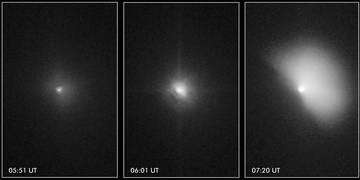The NASA/ESA Hubble Space Telescope captured the dramatic effects of the collision early July 4 between a 370-kilogram projectile released by the Deep Impact spacecraft and comet 9P/Tempel 1.
This sequence of images shows the comet before and after the impact. The image at left shows the comet about a minute before the impact. The encounter occurred at 7:52 a.m. CEST.
In the middle image, captured 15 minutes after the collision, Tempel 1 appears four times brighter than in the pre-impact photo. Astronomers noticed that the inner cloud of dust and gas surrounding the comet's nucleus increased by about 200 kilometres in size. The impact caused a brilliant flash of light and a constant increase in the brightness of the inner cloud of dust and gas.
The Hubble telescope continued to monitor the comet, snapping another image [at right] 62 minutes after the encounter. In this photo, the gas and dust ejected during the impact are expanding outward in the shape of a fan. The fan-shaped debris is travelling at about 1,800 kilometres an hour, or twice as fast as the speed of a commercial jet. The debris extends about 1,800 kilometres from the nucleus.
The potato-shaped comet is 14 kilometres wide and 4 kilometres long. Tempel 1's nucleus is too small even for the Hubble telescope to resolve.
The visible-light images were taken by the Advanced Camera for Surveys' High Resolution Camera.
Source: ESA
Image Credit: NASA, ESA, P. Feldman (Johns Hopkins University) and H. Weaver (Johns Hopkins University Applied Physics Laboratory)
























